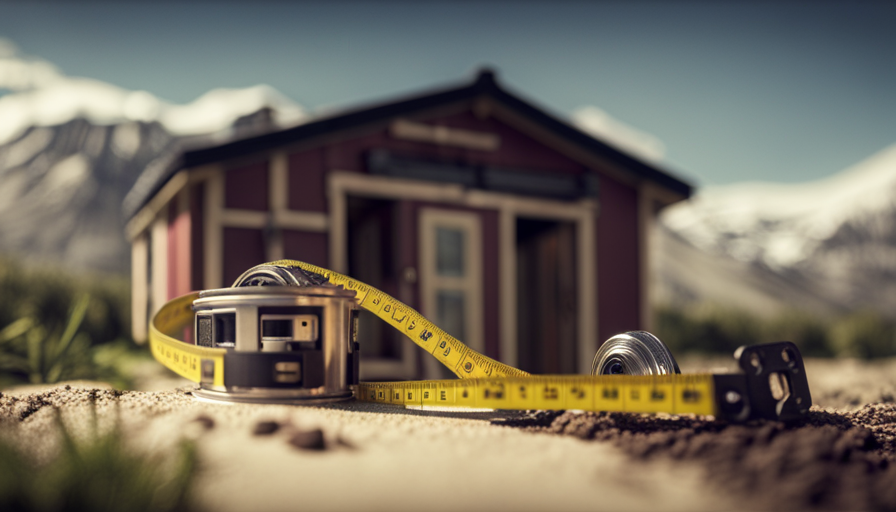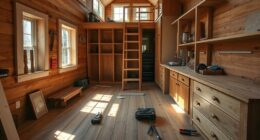In the world of real estate, finding the perfect home can sometimes feel like searching for a needle in a haystack. But what if that needle could be transformed into a cozy and affordable tiny house, offering a unique sense of freedom and flexibility?
Just like the needle, these tiny houses may seem small at first glance, but their potential for tax exemption can be much bigger than meets the eye.
Welcome to the world of tax-exempt tiny houses, where size doesn’t necessarily dictate their eligibility for tax benefits. Much like an enchanting puzzle, the rules and regulations surrounding tax exemption for tiny houses can be complex, requiring careful consideration and planning.
In this article, we will delve into the intricacies of tax exemption for these pint-sized dwellings, exploring factors such as square footage limitations, design considerations, and the permitting process. By examining real-life case studies and exploring alternative options for those that don’t meet tax exemption requirements, we hope to provide a comprehensive guide for anyone embarking on their tiny house journey.
So, let’s unravel the mysteries and discover just how big a tiny house can be to enjoy tax exemption.
Key Takeaways
- Tax exemption for tiny houses is possible regardless of size.
- Maximum square footage for tax exemption varies by local government.
- Meeting local government permitting requirements is crucial for tax exemption eligibility.
- Consult with a tax professional to understand the tax implications of a tiny house.
Understanding Tax Exemption for Tiny Houses
So you’re probably wondering, how big can your tiny house be to qualify for tax exemption? Well, the answer depends on the tax exemption eligibility criteria and regulations set by your local government. Each jurisdiction may have different rules regarding the size of a tiny house that can be considered for tax exemption.
Some places may define a maximum square footage, while others may base it on the number of rooms or occupants. To determine the maximum square footage for tax exemption, you will need to consult your local tax office or government website for specific guidelines. Understanding these regulations is crucial to ensure that your tiny house meets the requirements for tax exemption.
Now let’s move on to determining the maximum square footage for tax exemption.
Determining the Maximum Square Footage for Tax Exemption
Determining the maximum square footage for tax exemption can be as mind-boggling as trying to count the stars in the sky. The rules and regulations surrounding tax exemption for tiny houses vary from state to state, and even within different municipalities. It’s a complex web to navigate, but understanding the maximum square footage allowed for tax exemption is crucial.
To help you grasp the gravity of this topic, consider the following nested bullet point list:
- On one hand, some states have a strict maximum square footage limit of 400 square feet for tax exemption. This can be frustrating for those who desire a slightly larger tiny house.
- On the other hand, there are states that have more lenient policies, allowing up to 1,000 square feet for tax exemption. This offers more flexibility for individuals who want a slightly larger living space.
With these varying regulations in mind, it’s important to consider factors such as location, building codes, and personal preferences when designing a tax-exempt tiny house. This ensures compliance with regulations and maximizes the benefits of tax exemption.
Factors to Consider When Designing a Tax-Exempt Tiny House
When planning your small abode, it’s essential to take into account various factors that can impact your eligibility for tax exemption.
One of the most important considerations is meeting the permitting requirements set by your local government. Each jurisdiction has different regulations regarding the size, location, and construction of tiny houses, so it’s crucial to research and comply with these guidelines.
Additionally, understanding the tax implications of your tiny house is vital. Some states may offer tax incentives or exemptions for certain types of dwellings, while others may not. It’s advisable to consult with a tax professional to ensure you’re aware of any potential tax benefits or liabilities associated with your tiny house.
By carefully considering these factors, you can navigate the permitting process and maximize your chances of achieving tax exemption for your tiny house.
Transitioning into the next section, let’s explore how to navigate the permitting process for tax-exempt tiny houses.
Navigating the Permitting Process for Tax-Exempt Tiny Houses
Navigating the permitting process for tax-free small dwellings can be a complex journey, but with the right knowledge and guidance, you can successfully pave the way towards achieving your dream abode. When it comes to building a tax-exempt tiny house, it’s important to understand the permitting process and the building codes that apply. Municipalities have different regulations, so it’s crucial to research and comply with the specific requirements of your area. To help you navigate this process, I have created a table outlining some common considerations:
| Consideration | Description |
|---|---|
| Zoning regulations | Determine if tiny houses are allowed in your area and under what conditions. |
| Building codes | Ensure your tiny house meets all safety and construction standards. |
| Permit requirements | Determine the necessary permits and inspections for your project. |
By understanding and adhering to these factors, you can ensure a smoother permitting process for your tax-exempt tiny house. Now, let’s address some common misconceptions about tax-exempt tiny house size.
Common Misconceptions about Tax Exempt Tiny House Size
Don’t let misconceptions about the size of your dream home hold you back – it’s like thinking you can’t have a fulfilling life because you’re not a skyscraper, when in reality, a cozy cottage can offer just as much joy and comfort.
When it comes to tax-exempt tiny houses, there are common misconceptions about the size limitations. However, the truth is that the size of a tiny house eligible for tax exemption can vary depending on local zoning regulations. Some areas may have specific square footage requirements, while others may focus on other factors such as the overall footprint or the number of rooms.
Understanding the specific zoning regulations in your area is crucial to determine the maximum size of your tax-exempt tiny house. By taking advantage of tax exemption benefits, you can save money and enjoy the freedom of living in a smaller, more sustainable home.
Now, let’s explore some case studies: examples of tax-exempt tiny houses.
Case Studies: Examples of Tax-Exempt Tiny Houses
Imagine the joy and freedom of living in a small, sustainable home while saving money through tax exemption benefits – let’s explore some inspiring case studies of individuals who have achieved just that with their cozy, dream dwellings.
These case studies provide real-life examples of how individuals have successfully navigated the tax exempt criteria for tiny houses.
One such case study is Sarah, who built a 200 square foot tiny house on a foundation and qualified for tax exemption by meeting the size and sustainability requirements set by her local government.
Another case study is John, who opted for a 250 square foot tiny house on wheels and was able to obtain tax exemption by meeting the criteria for mobility and sustainability.
These examples demonstrate that with careful planning and adherence to the tax exempt criteria, individuals can enjoy the benefits of tax exemption while living in their ideal tiny homes.
Now, let’s explore alternative options for tiny houses that don’t meet tax exemption requirements.
Alternative Options for Tiny Houses that Don’t Meet Tax Exemption Requirements
Explore other avenues for your compact abode that may not qualify for tax exemption, but are as refreshing as a cool breeze on a hot summer day. If your tiny house doesn’t meet the requirements for tax exemption, don’t worry, there are still alternative options available to you.
One option is to explore alternative financing methods such as personal loans or crowdfunding platforms specifically designed for tiny house projects. These options can provide the necessary funds to build your tiny house without relying on tax exemptions.
Additionally, it’s important to consider zoning regulations when looking for alternative options. Some areas may have zoning restrictions that make it difficult to legally place a tiny house. However, there are communities and developments that cater to tiny house living and have specific zoning regulations in place to accommodate these unique dwellings.
By exploring alternative financing and understanding zoning regulations, you can still find a way to make your tiny house dream a reality.
Frequently Asked Questions
Can I claim tax exemption for my tiny house if it is used as a primary residence?
Yes, you can claim tax benefits for your tiny house if it’s used as your primary residence. The IRS allows homeowners to deduct mortgage interest and property taxes on their primary residence, regardless of its size. However, it’s important to note that there’s no specific size limit for tiny houses to be tax exempt. As long as your tiny house meets the requirements of a primary residence, you can enjoy the tax benefits associated with it.
Are there any specific requirements for the location of a tax-exempt tiny house?
There are specific requirements for the location of a tax-exempt tiny house, including zoning regulations. Zoning regulations vary by jurisdiction and determine where different types of structures, including tiny houses, can be located.
It’s important to research and comply with local zoning laws to ensure that your tiny house is in a suitable location for tax exemption. Factors such as minimum lot size, setbacks, and allowed land uses may all impact the eligibility of a tiny house for tax exemption.
Is there a limit on the number of rooms or sleeping areas allowed in a tax-exempt tiny house?
There isn’t a specific limit on the number of bedrooms or sleeping areas allowed in a tax-exempt tiny house. However, it’s important to note that the living space should still adhere to the guidelines for a tiny house to qualify for tax exemption.
While the number of bedrooms can vary, it’s crucial to maintain the overall compactness and efficiency of the tiny house. This ensures that it remains within the acceptable size limits.
Can I still qualify for tax exemption if my tiny house is on wheels and considered a recreational vehicle?
Yes, you may still qualify for tax exemption even if your tiny house is on wheels and considered a recreational vehicle. However, it’s important to note that tax exemption eligibility varies depending on your jurisdiction. To ensure you meet the criteria, consult with a tax professional or local authorities.
Additionally, when considering a tiny house on wheels, it’s crucial to explore insurance options specifically designed for tiny homes and research financing options that cater to this unique type of housing.
Are there any additional tax benefits or incentives for incorporating sustainable features into a tax-exempt tiny house?
Incorporating sustainable features into a tax-exempt tiny house can provide additional tax benefits and incentives. For example, installing solar panels can qualify you for the federal solar investment tax credit, which allows you to deduct a percentage of the installation cost from your taxes. This not only helps the environment but also saves you money in the long run.
Additionally, using energy-efficient appliances and materials can potentially qualify you for other tax deductions or credits.
Conclusion
After delving into the intricacies of tax exemption for tiny houses, it becomes clear that size does matter. While there are limitations to the square footage, the possibilities are still vast.
Designing a tax-exempt tiny house is a delicate balance of creativity and adherence to regulations. Navigating the permitting process may seem daunting, but with persistence, it can be conquered. So don’t be discouraged if your dream tiny house doesn’t meet the exemption requirements, as there are alternative options to explore.
Remember, even in the smallest of spaces, big dreams can thrive.
Hi, I’m Emma. I’m the Editor in Chief of Tiny House 43, a blog all about tiny houses. While tree houses are often associated with childhood, they can be the perfect adult retreat. They offer a cozy space to relax and unwind, surrounded by nature. And since they’re typically built on stilts or raised platforms, they offer stunning views that traditional homes simply can’t match. If you’re looking for a unique and romantic getaway, a tree house tiny house might just be the perfect option.
















